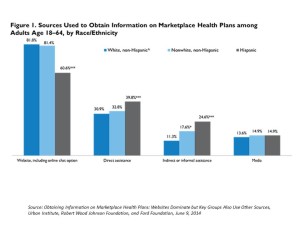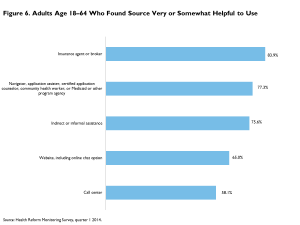
A vast majority of people shopping for a health plan on a Health Insurance Exchange for coverage in 2014 obtained information online via websites. One-half of these shoppers used only online information, and 29% combined both websites and other sources like direct assistance, informal assistance, and via (offline) media.
In the Health Reform Monitoring Survey from the Urban Institute Health Policy Center, a research team, funded by the Robert Wood Johnson Foundation and the Ford Foundation, looked into data collected from the Health Reform Monitoring Survey in March 2014 at the end of the 2014 open enrollment period for the Affordable Care Act.
While most people across all age groups looked online for health insurance information for 2014 plans, more people 55-64 (the oldest age cohort in the study) looked for direct assistance (from call centers, navigators, community health workers, and health insurance brokers, among other offline help). Older people also turned to (offline) media than shoppers in the youngest age group, 18-34. Roughly equal percentages across all ages (about 16%) looked to informal sources, like friends and family, hospitals and employers.
Most people overall believe found most helpful sources to use for seeking information on health insurance were insurance agencies and brokers (among 84%); navigators, counselors, community health workers and Medicaid agencies and the like (77%); indirect and informal sources such as family and friends, doctors, etc. (76%); websites, including chat options (65%); and, call centers (58%).
Health Populi’s Hot Points: The clear finding from this study is that more people found offline help more useful than websites, and this is particularly true among certain population segments. Underneath the top-line numbers lies the fact that people who identify as Hispanic or lower-income were less likely to use a website and more likely to use informal and direct assistance to get informed about health insurance options.
It takes a village of hands-on, offline people to introduce, educate and enroll uninsured people in health insurance plans, this study shows. It is easy to be techno-optimists when it comes to the role of the Internet in health care — Wi-Fi is fairly ubiquitous, most people in the U.S. have smartphones, and there’s more than ample supply of “health care information” online. Websites were and are very important as information sources.
But the fact remains that most people who purchased health insurance for 2014 in an online marketplace were previously insured, based on McKinsey’s analysis. Because so many of the uninsured population in America live offline, and may trust offline relationships more than online ones, marketing tactics for Health Insurance Marketplaces and insurance plans in Year 2 of the Affordable Care Act implementation should bolster offline efforts — as The Urban Institute team coins, direct and indirect assistance, and informal channels — here, doctors, hospitals and clinics that serve a large proportion of uninsured people could be practical outreach channels.





 I'm in amazing company here with other #digitalhealth innovators, thinkers and doers. Thank you to Cristian Cortez Fernandez and Zallud for this recognition; I'm grateful.
I'm in amazing company here with other #digitalhealth innovators, thinkers and doers. Thank you to Cristian Cortez Fernandez and Zallud for this recognition; I'm grateful. Jane was named as a member of the AHIP 2024 Advisory Board, joining some valued colleagues to prepare for the challenges and opportunities facing health plans, systems, and other industry stakeholders.
Jane was named as a member of the AHIP 2024 Advisory Board, joining some valued colleagues to prepare for the challenges and opportunities facing health plans, systems, and other industry stakeholders.  Join Jane at AHIP's annual meeting in Las Vegas: I'll be speaking, moderating a panel, and providing thought leadership on health consumers and bolstering equity, empowerment, and self-care.
Join Jane at AHIP's annual meeting in Las Vegas: I'll be speaking, moderating a panel, and providing thought leadership on health consumers and bolstering equity, empowerment, and self-care.